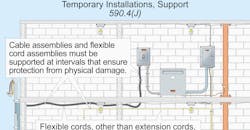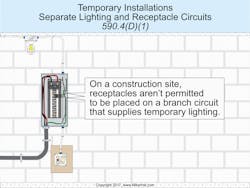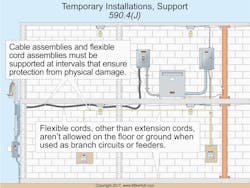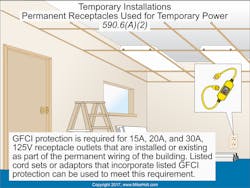It’s a common misconception that temporary wiring represents a lower standard than that of other wiring. In truth, it merely meets a different standard. The same rules of workmanship, ampacity, and overcurrent protection apply to temporary installations as to others.
How is a temporary installation different? In one sense, it does represent a lower standard. For example, you can use Type NM cable rather than raceway-enclosed wiring without any limitations based on the type of construction, and you don’t have to put splices in boxes.
However, you must remove a temporary installation upon completion of the purpose for which it was installed. If the temporary installation is for holiday displays, it can’t last more than 90 days [590.3].
Article 590 addresses the practicality and execution issues inherent in temporary installations, thereby making them less time consuming to install. Its requirements apply only to temporary power and lighting installations, including power for construction, remodeling, maintenance, repair, demolition, and decorative lighting.
This Code Article also applies when temporary installations are necessary during emergencies or for tests and experiments [590.3(C)].
Temporary installations for trade shows must comply with Art. 518, and temporary installations for carnivals, circuses, fairs, and similar events must be installed per Art. 525, not Art. 590.
Rules by circuit type
Services must be installed in accordance with Parts I through VIII of Art. 230, as applicable [590.4(A)].
In feeders and branch circuits, open conductors aren’t permitted [590.4(B) and (C)]. However, cable assemblies and hard usage and extra-hard usage cords, and the following wiring methods are permitted:
• Type NM and Type SE cables, exposed or concealed, can be used for temporary power in any building, without any height limitations based on the type of construction.
• Type SE cable can be installed within an underground raceway.
Receptacles
On a construction site, receptacles aren’t permitted to be placed on a branch circuit that supplies temporary lighting [590.4(D)] (Fig. 1). This requirement is necessary so that illumination is maintained, even when the receptacle’s GFCI-protection device opens. The last thing you want is people groping around in the dark. To avoid this outcome, consider supplying lights from more than one branch circuit if practical.
If you install 15A and 20A receptacles in a wet location, they must be within an enclosure that’s weatherproof when an attachment plug is inserted. The outlet box hood must be listed for “extra-duty” use, and all nonlocking-type 15A and 20A, 125V and 250V receptacles in a wet location must be listed as weather resistant [406.9(B)(1)].
Disconnecting means
Ungrounded conductors of a multiwire branch circuit must have a disconnect at the power outlet or panelboard [590.4(E)]. And it must open all of the ungrounded conductors simultaneously. Individual single-pole circuit breakers with handle ties identified for the purpose, or a breaker with common internal trip, can be used for this application [240.15(B)(1)].
See the definition of “Panelboard” in Art. 100. For additional multiwire branch-circuit requirements, see Sec. 210.4 and Sec. 300.13(B).
Lamp protection
Lamps (bulbs) must be protected from accidental contact or breakage by a suitable luminaire or by the use of a lampholder with a guard [590.4(F)]. One reason for this rule is to prevent skin burns. Newer types of work lights, including units capable of general illumination, use LEDs and thus eliminate this problem. The LEDs themselves, operating at around 5VDC, also eliminate the shock hazard. The luminaire also puts the LED behind a lens (unlike the traditional “drop cord” light).
If you are using only LED lighting on your jobs, does protection still matter? The glass lenses of LED work lights can break, so yes. Your concern now would shift from protecting personnel from the lamps to protecting the lamps from personnel.
Splices
According to NFPA 2017 TIA 17-4, (Tentative Interim Amendment) to Sec. 590.4(G), a box, conduit body, or other enclosure, with a cover is required for all splices.
Exception
On construction sites, a box, conduit body, or other enclosure isn’t required for either of the following:
1. The circuit conductors are from nonmetallic multiconductor cord or cable assemblies, provided that the equipment grounding continuity is maintained with or without the box.
2. The circuit conductors are from metal-sheathed cable assemblies terminated in listed fittings that mechanically secure the cable sheath maintaining effective electrical continuity.
Some people misconstrue the lack of required boxes as a signal that other rules don’t apply. The reason permanent installations require putting splices in boxes is for long-term protection. By definition, a temporary installation is not long-term. This in no way means that twisting wires together and then wrapping them in tape is acceptable. Make the splices using approved methods.
Another rule, not explicitly stated here, must also be met. The splice must not be exposed to physical damage. If you need to protect the splice, then do so — even if that means putting it in a box. Boxes aren’t required for all splices, but they are allowed and should be used if conditions warrant.
Cables and flexible cords
Cables and flexible cords must be protected from accidental damage and from sharp corners and projections [590.4(H)]. Protection must also be provided when cables and flexible cords pass through doorways or other pinch points.
Support is also critical. Cable assemblies and flexible cords must be supported at intervals that ensure protection from physical damage. Support must be in the form of staples, cable ties, straps, or other similar means designed not to damage the cable or flexible cord assembly. Flexible cords, other than extension cords, aren’t permitted on the floor or the ground when they’re used as branch circuits or feeders [590.4(J)] (Fig. 2).
The support requirement for temporary cables is determined by the authority having jurisdiction (AHJ), based on the jobsite conditions [590.2(B)]. How can you know what this requirement is, ahead of time? If you use good judgment rather than try to see what you can get by with, you won’t have to worry about that.
If you’re unsure how much support is enough, remember those supports don’t cost very much. Nobody gets cited for having five supports instead of the four that probably would have been sufficient.
You can’t use vegetation to support overhead branch-circuit or feeder conductors. But there is an exception. Vegetation can be used to support holiday lighting if strain-relief devices, tension take-up devices, or other means approved by the AHJ are used to prevent damage to conductors from the movement of the live vegetation [590.4(J) Ex.].
Ground-fault protection for personnel
Ground-fault protection for personnel is required for temporary wiring used for construction, remodeling, maintenance, repair, or demolition of buildings, structures, or equipment [590.6(A)].
GFCI protection is required for all 15A, 20A, and 30A, 125V receptacles that are:
• Not part of the permanent wiring of the building or structure and that are in use by personnel. In addition to the required GFCI protection for personnel, listed cord sets or devices incorporating listed ground-fault circuit-interrupter protection for personnel identified for portable use are permitted (the “In addition to…” part was added with the 2017 NEC for clarity) [590.6(A)(1)].
• Installed or existing as part of the permanent wiring of the building. Listed flexible cord sets or devices that incorporate listed GFCI protection can be used to meet this requirement [590.6(A)(2)] (Fig. 3).
All 125V and 125/250V single-phase 15A, 20A, and 30A that are part of a portable generator rated not greater than 15kW must have listed GFCI protection [590.6(A)(3)].
For temporary wiring installations, receptacles (other than those just covered above) that supply temporary power used by personnel during construction, remodeling, maintenance, repair, or demolition of buildings, structures, equipment, or similar activities must be GFCI protected per one of the following:
• GFCI protection. Ground-fault circuit-interrupter (GFCI) protection for personnel [590.5(B)(1)].
• SPGFCI protection. Special purpose ground-fault circuit-interrupter protection for personnel [590.5(B)(2)].
• Assured equipment grounding conductor program. A written assured equipment grounding conductor program continuously enforced at the site to ensure equipment grounding conductors for all cord sets, receptacles that aren’t a part of the permanent wiring of the building or structure, and equipment connected by cord and plug, are installed and maintained per Secs. 250.114, 250.138, 406.4(C), and 590.4(D) [590.5(B)(3)].
Temporary work and permanent consequences
Good workmanship and attention to detail is just as important for temporary installations as it is for permanent ones. That applies to all connections, whether in a box or not. And it applies to how you route, support, and protect conductors. Plus the other factors addressed in Art. 590. Yes, the completed electrical work itself is temporary. But an electrocution is permanent.
Holt is the owner of Mike Holt Enterprises, Inc. in Leesburg, Fla. He can be reached at www.mikeholt.com.Save
About the Author

Mike Holt
Mike Holt is the owner of Mike Holt Enterprises (www.MikeHolt.com), one of the largest electrical publishers in the United States. He earned a master's degree in the Business Administration Program (MBA) from the University of Miami. He earned his reputation as a National Electrical Code (NEC) expert by working his way up through the electrical trade. Formally a construction editor for two different trade publications, Mike started his career as an apprentice electrician and eventually became a master electrician, an electrical inspector, a contractor, and an educator. Mike has taught more than 1,000 classes on 30 different electrical-related subjects — ranging from alarm installations to exam preparation and voltage drop calculations. He continues to produce seminars, videos, books, and online training for the trade as well as contribute monthly Code content to EC&M magazine.




